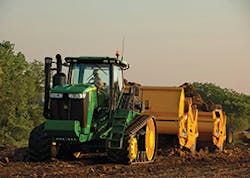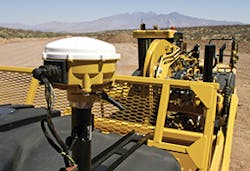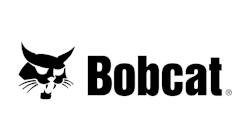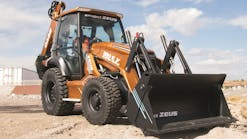Everyone knows that scrapers provide an economical method for moving dirt, but because every job is different, choosing the right scraper can be complicated. However, in order to be more competitive in bidding jobs and more efficient on the job site, contractors need to understand the benefits of each scraper in different applications.
Considerations in the decision-making process include the following:
- Total yards of material to be moved
- Soil type and ground conditions
- Size of job site
- Haul distance
- Schedule/amount of time available
- Manpower available
- Support equipment available
The last two variables in particular can influence the choice of equipment “partners” for maximum productivity. As Shane Kroeker, marketing manager for K-Tec Earthmovers Inc., says, “Efficient pairing of equipment is providing advantages for a wide variety of construction projects.”
He suggests articulated dump trucks for an advantageous return on investment and increased profitability because of their speed and the self-loading option. In addition, an ADT/scraper package typically costs less than the purchase price of a traditional self-propelled scraper.
Since the partnership fostered in July 2013 with Volvo CE, K-Tec has promoted use of a Volvo ADT with a K-Tec ADT scraper. The ADT/scraper pairing provides a more fuel-efficient solution. “Traditional self-propelled scrapers typically weigh more,” Kroeker states. That causes more issues in wet job site conditions, when compared with other earthmoving equipment.
Kroeker cites such applications as airport runway expansions, road building, cattle feed lots, and retention ponds that benefit from ADT/scraper pairings. Contractors can top-load material because the target opening, while similar in size to an ADT, is lower to the ground-an advantage for the excavator operator. Contractors can convert their ADT to pull a scraper by removing the box. Flexibility saves money because contractors can use their ADTs to pull a scraper, without the need to purchase additional machinery.
“It comes down to using the correct piece of machinery for the job,” Kroeker notes. “Rock trucks excel at hauling rock, while scrapers are the most efficient option when moving dirt.
“A contractor company in Kansas eliminated six traditional self-propelled scrapers from their fleet by replacing them with three pairs of ADT/scrapers,” Kroeker continues. Another contractor in Wyoming claims that the efficient duos out-perform traditional self-propelled scrapers.
Similarly, Kelly Goossen, senior vice president of sales at K-Tec, says one Illinois contractor replaced four traditional self-propelled scrapers and eight ag scrapers from another manufacturer with six K-Tec ADT units. “Due to very wet ground conditions, the ADT scrapers where able to run while the traditional self-propelled scrapers were not. We out-cycled the AG scrapers 2 to 1.”
The ADT/scraper combination is an obvious upgrade over the ADT/excavator earthmoving setup, Kroeker says, because contractors can get the job done more efficiently, with less machinery. “This means that not only will the upfront investment be less, but the variable costs of labor, fuel, and maintenance will all be significantly less” than the typical earthmoving setup consisting of one excavator, two ADTs and a dozer, plus the manpower to run all the machines. The use of an ADT as a scraper power unit allows the contractor to maintain a fast speed, with a self-loading option. “When you consider that an ADT/scraper can self-load in as little time as 60 seconds, while an ADT top-loaded with an excavator can easily take up to 120 seconds, the productivity is astounding.”
Sizing Up the Equipment
To maximize efficiency, it’s imperative to match a power unit’s horsepower with the size of the scraper being pulled.
K-Tec’s Goossen lists some of their popular pairs. The 1233 ADT offers self-loading, pull-pan versatility. The most popular model in their fleet, it is a multipurpose machine capable of tackling any soil condition with loading speed and fuel efficiency. You don’t need a dozer to load it, he says, just a 40-ton truck to pull it. “It travels faster than a traditional scraper with an ag tractor,” he says.
Because the 9.525 ADT is narrow, it is suited for urban sites, where maneuverability and width restrictions challenge other equipment.
Known as the world’s largest dirt-moving scraper, the 1254, introduced at Con Expo 2011, is push-loaded. Designed to be pulled by a 40-ton, 450-plus horsepower rock truck, it is a “mass dirt hauler,” Goossen describes, capable of hauling more than a million cubic yards for minimal distances at speeds up to 30 mph, loaded.
According to Goossen, a single K-Tec scraper out-performs a set of 17″“21 yard trains, which weigh more in steel alone. “A single scraper loads faster, cycles faster, and has better fuel efficiency. It’s easier on the tractor if you never pulled trains.”
In addition to rapid cycle times and less fuel consumption, K-Tec scrapers are known for superior flotation. “Automatic ride control provides a smoother ride,” Goossen says, “and less stress on the power unit.”
Capable of self-loading in many situations, the K-Tec scraper requires less support equipment, and, consequently, fewer personnel. As of 2014, all their scrapers are brake-compatible, with a patent-pending antilock brake system featuring patent-pending calipers. “The amount of brake force correlates to the weight in the scraper,” Goossen elaborates. This meets OSHA safety regulations.
Beyond Limitations
Confessing that “there’s always a place for a construction or ag tractor to pull a scraper,” and that “under a half-mile, it’s difficult to beat an ag tractor and scraper,” Goossen says an ag tractor has limitations. Some contractors don’t want to bring them to job sites.
“A self-propelled scraper has only one use; the market is limited,” he explains. “The market shifted to a rock truck and excavator due to Cat’s dominance, but it’s cheaper to move dirt with a scraper.”
A rock truck is not self-supportive, he explains, but the option to attach an ADT to a rock truck for speed aids in a competitive industry. “The flexibility of being able to use a rock truck is enormous,” Goossen states. It allows a contractor to use a standard construction power unit to pull a scraper, and enables him to maintain transport speed while hauling more material.
More flexibility may be in store. Goossen, who says K-Tec has been “focused on building the best scraper money can buy” since the company was founded in 2001, discloses that a design team is actively working on multiple new innovations with staged implementation over the foreseeable future. “We are not only focusing on the next year, but have the concepts for new technology that will be implemented over a 10- to 15-year window,” he notes. “The technology is there.”
Pulling Productivity
Some technology is already here. The I-220TS4 ejector scraper from Ashland Industries had its debut at Con Expo. Ashland, established in 1953, is now affiliated with Case I-H.
Will Davis, North American sales manager, calls the I-220TS4 a “modified and improved version of the I-180TS2 that improves on the 20-yard [scraper] from three years ago.” Compatible with high-horsepower rubber-tracked or wheeled tractors, it is a new design in the 22-yard forced ejection scraper category, he reports. The advantage it has over dump-style scrapers is that it cleans the bowl completely. “When you get 30% moisture in the spring, you have heavy, wet material that collects in the corners [of a dump-style scraper].”
“Scrapers are often the first piece of equipment onsite-and in the worst areas,” Davis continues. Where the soil is spongy and the ground is rutted, they have to drain the water before work can begin. “This doesn’t pump the soil so bad; it floats over the top. We can go in sooner and open [a site] before a conventional scraper. If we get an inch of rain today, we can go in tomorrow.”
That can make a big difference on a job with a tight deadline. Further assisting time limitations, it cycles more quickly, thanks in part to its 10.5-foot cut that equals gained yardage in the apron. “If you gain an extra tow or three loads per hour, you gain 16 to 20 by the end of an eight-hour day. That’s a big savings.”
Some of the savings can be attributed to the fact that the scraper can be pulled by a 200-horsepower tractor. “Productivity goes up when you pair an ag tractor with a scraper,” Davis says, “because you can load faster. It can load by itself; you don’t need a dozer to fill the scraper.” He compares that pairing with a tandem scraper pulled by a 400-horsepower ADT: “Productivity decreases.”
In mining, Davis explains, “they’re paid by the load, so they go fast. It’s tough on a scraper. The accumulator takes some of the shock, but there’s a lot of stress on rough terrain.” As tractor horsepower has increased, Ashland has built tougher scrapers, adding more strength. “It’s a big step from the old model. More horsepower, more torque rise, higher pressure-all add stress.”
Another advantage of using a tractor is its versatility. “You can unhook it and use it with other equipment,” Davis says. “We make an adaptor to turn the hitch to use different implements.”
Towed scrapers are also easier to transport than the self-powered alternative, Davis notes. “You can put two scrapers on a tractor without being over width, so you don’t need an escort or a permit.” It’s a benefit on roads with weight limits and on narrow bridges. It also helps keep a fleet mobile. “Typically, you’re onsite a week to 10 days before you go to the next project.”
Ashland’s 15 models range from 9.5 to 22 yards, plus a 2.5-yard model that fits on the front of a skid-steer. While the smaller unit is used by landscape contractors around housing, government trails, and feedlots, the bigger scrapers are commonly used in road building and site prep. Davis lists jobs that include shopping malls, a Toyota plant, the Harley Davidson plant in Kansas City, golf courses, and airports.
The light ground pressure produced by Ashland scrapers is an advantage when working in loose or sandy soil. “We do a lot of levee systems and landfills,” Davis indicates. “We keep the psi down around 5 to 8 pounds per square inch because of compaction or to distribute the remaining soil there.”
Level Best
Another scraper that’s good to use in sandy soil is Bonnell Industries Inc.’s Perfect Road Maintainer. The 312 eliminates ruts and wash-boarding by using a series of six cutting and mixing blades and one finishing blade at the rear that mix the material three times and then leveled off in one pass, without the need of a motor grader. “It pulls the material into the center, then drags it out to the side,” explains Joe Bonnell, president. “The back blade strikes off to the desired pitch.”
It works especially well for secondary road maintenance. “It’s an excellent choice for road maintenance,” Bonnell continues. “It’s a cost-effective way to maintain secondary roads. Most [scrapers] pick up dirt and transport it, then drop it off. This redistributes it. It takes the loose gravel at the shoulder that’s been washed away and fills potholes. It fixes tire damage.”
Popular with townships and county highway departments, the Perfect Road Maintainer is useful for gravel parking lots and land leveling. With its single blade and massive hydraulic down-pressure, “it does the same job as a motor grader,” Bonnell says.
“Regular” scrapers cannot put aggressive down-pressure on the blades, Bonnell explains. “They only have the weight of the machine and forward motion-and they have to go out in ideal conditions.” The 312, conversely, can work “a couple days after rainfall.” Alternately, the scarifier cutting edges can be put on the front; it helps keep rocks in the ground.
Every time a motor grader is in motion, it leaves material off the moldboard. Bonnell’s Windrow Eliminator, with a light-duty blade mounted on the back, moves loose material, striking off the windrow left by the motor grader. The wheels help gauge, leaving less material on the side. “It grabs the windrow and strikes it back off, helping create pitch,” Bonnell says. “It could save an entire pass if doing shoulder work.”
Neither of these are new designs; Bonnell has been making them since the 1960s. Surprisingly, he says, they aren’t in widespread usage. “In regions with a lot of loose gravel roads, there are not a lot of them.” New Jersey has only 18 motor graders to maintain 900 miles of roadways. If the state acquired one Perfect Road Maintainer for every grader, it could save hours of road work. “If you use a motor grader every month, you can reduce that to every three months [by using the Perfect Road Maintainer].”
Being able to do grading work without a grader promotes cost savings, allowing counties to maintain roads more often. “It’s more efficient than a motor grader,” Bonnell points out. “You can pull it with a tractor or a single-axle truck, such as a snow plow or tandem truck. It’s more fuel-efficient, and has faster speed and lower operating cost. It’s cost-efficient.”
The 312 is more maneuverable, and can be pulled by a smaller truck. That’s handy for the short Illinois roads. However, he emphasizes, it is not intended to replace a motor grader, but, rather, to supplement it. “Nebraska has very sandy soil. They use it constantly-about every 10 days.”
Managing Efficiency
The beauty of the tractor and pull scraper system is that it’s well suited for a wide variety of applications, thanks to its flexibility. In addition to site prep for residential and commercial building sites, the combo is adept at pond and levee construction, heavy highway construction, and precision land leveling (when combined with a grade control system). David Wilson, product marketing manager, scraper systems, John Deere Construction & Forestry, says that “many users have found this system to be an economical way to construct new landfill cells and move cover material in municipal waste management.”
John Deere manufactures nine models of pull scrapers, five carryall models and four ejector models. The company’s 15-, 18-, and 21-cubic-yard scrapers are available in 10-, 12-, and 14-foot widths.
The biggest innovation since the introduction of scraper systems is the John Deere exclusive Autoload system. According to Scott Bayless, product consultant, scraper systems, this system allows an inexperienced operator to load tandem scrapers to a level of production within 5% of an experienced operator. “It substantially reduces the amount of training time needed for a new operator to become productive with the system.” The system takes various operating parameters from the tractor and scraper, and allows the tractor to automatically load each scraper without operator intervention.
Fully equipped with grade control, this Caterpillar scraper can provide precision, no matter how rough the conditions.
Even experienced operators benefit from Autoload because scraper heights can be preset for transport and dump heights. This allows the operator to return the scraper to the same transport and dump heights by pressing one button, without looking back at the scraper.
Another feature of the Deere 9R Series tractors that substantially reduces fuel consumption is the Efficiency Manager mode of the 18-speed transmission. By allowing the tractor’s Efficiency Manager Controller to manage the engine throttle and gear selection that best matches a target transport speed, operators are able to reduce fuel consumption up to 30%.
Wilson and Bayless evaluate the efficiency of the system as it’s related to the cost to move a cubic yard of material. Broken down into a couple different areas, the first consideration is the initial investment. “The purchase price of a towed scraper system will be 30% to 40% of an equivalent capacity, self-propelled scraper that will more than likely include two twin-engine scrapers,” Wilson notes.
The second factor is the labor involved with moving that material. The towed scraper system uses one operator, while the self-propelled system will use a minimum of two. If the two scrapers are single-engine units, the labor requirement jumps to three because of the need to have a dozer operator push-load the scrapers.
The final factor is the operating cost of the towed scraper system compared with that of self-propelled scrapers. To move the same amount of material, the towed scraper system will use one engine, compared with three (two single-engine scrapers and a dozer), or even four engines (two twin-engine scrapers), all of which are consuming significantly more fuel per hour. With fuel costs playing a more significant role the last few years, Bayless says, it’s easy to see how the towed scraper system usually returns a much lower cost per cubic yard, compared with other methods.
Not Limited by Material Type
While several types of scrapers work well in sand, the Cat wheel tractor-scraper works in a range of material, from sand to rock as large as 24 inches. “The construction of a Cat WTS allows it to work in very tough conditions and material types,” states John Gerhold, wheel tractor-scraper application specialist. “[Towed scrapers] are limited on material type.”
The Cat WTS is designed to work in a variety of settings:
- Mining commodities like coal, silicon sand, chalk, and bauxite
- Mine reclamation
- Mine-stripping applications
- Dam construction
- Heavy highway and development construction
- Landfill cell construction
“Basically,” Gerhold sums up, “if the loaded haul is less than 10,000 feet and the material has rock that is 24 inches in size or less, a Cat WTS can be considered as a possible hauling system.”
The next step is to evaluate what type of loading method the customer is using to decide if single- or twin-engine power is needed.
Another difference involves the durability of machine construction. “The Cat WTS is designed to not only work in tough conditions, but live multiple lives through machine rebuilds,” Gerhold says. A typical towed-scraper system, working in material that contains no rock and material density of less than 3,000 pounds, will need to be replaced between 5,000 to 7,000 hours. Gerhold says it’s not uncommon to find a Cat WTS working in production applications with 30,000-plus hours. “Cat WTSs are designed to be an investment that can provide a long working life to a single customer or multiple customers.”
Caterpillar offers six wheel tractor-scrapers in North America. Cat self-powered scrapers are available in sizes ranging from 23 to 73 cubic yards. In March 2014, the company began production of the 623K Single Engine Elevating Bowl (23-cubic-yard capacity), and the 621K Single Engine and the 627K Twin Engine Open Bowl (24-cubic-yard capacity).
The 620 Series includes three machines that were redesigned and introduced as H models at the last CONEXPO, says Mark Sprouls, with Caterpillar Trade Press Relations. They became commercially available last year.
The 623H is the only elevating WTS in the line. It uses chain-driven paddles to help load the bowl, which enables it to load without assistance from a push dozer or another scraper in a push-pull arrangement. The 623H is truly a work-alone machine as it loads itself and, as all scrapers do, spreads material in the dump area.
The 621H is a single-engine WTS with an open bowl scraper; the 627H is a twin-engine WTS with an open bowl scraper. Open bowl scrapers sometimes load themselves, Sprouls notes, but most often, they are pushed by a dozer when loading, or they work in tandem with another WTS in a push-pull arrangement.
Each of the push-pull WTSs has a hydraulically operated bail on the front of the tractor and a push block with hook on the tail of the scraper. When loading, the trailing scraper hooks its bail on the tail of the leading scraper, and the trailing scraper pushes while the front one loads. Then, the front one pulls the trailing one as it loads. The push-pull hardware is an option on both the 621H and 627H. “In the right conditions, push-pull scrapers can be the lowest cost means of moving large amounts of material, because they load quickly, travel fast, and spread material as they dump on-the-go,” Sprouls says.
The 631G is single-engine machine; the 637G is a twin-engine machine. Both are available in push-pull configurations.
The 657G is the biggest WTS in the line and is generally used in mass earthmoving jobs such as big civil works projects and new highway construction. Caterpillar has a grade-control system for the WTS.










